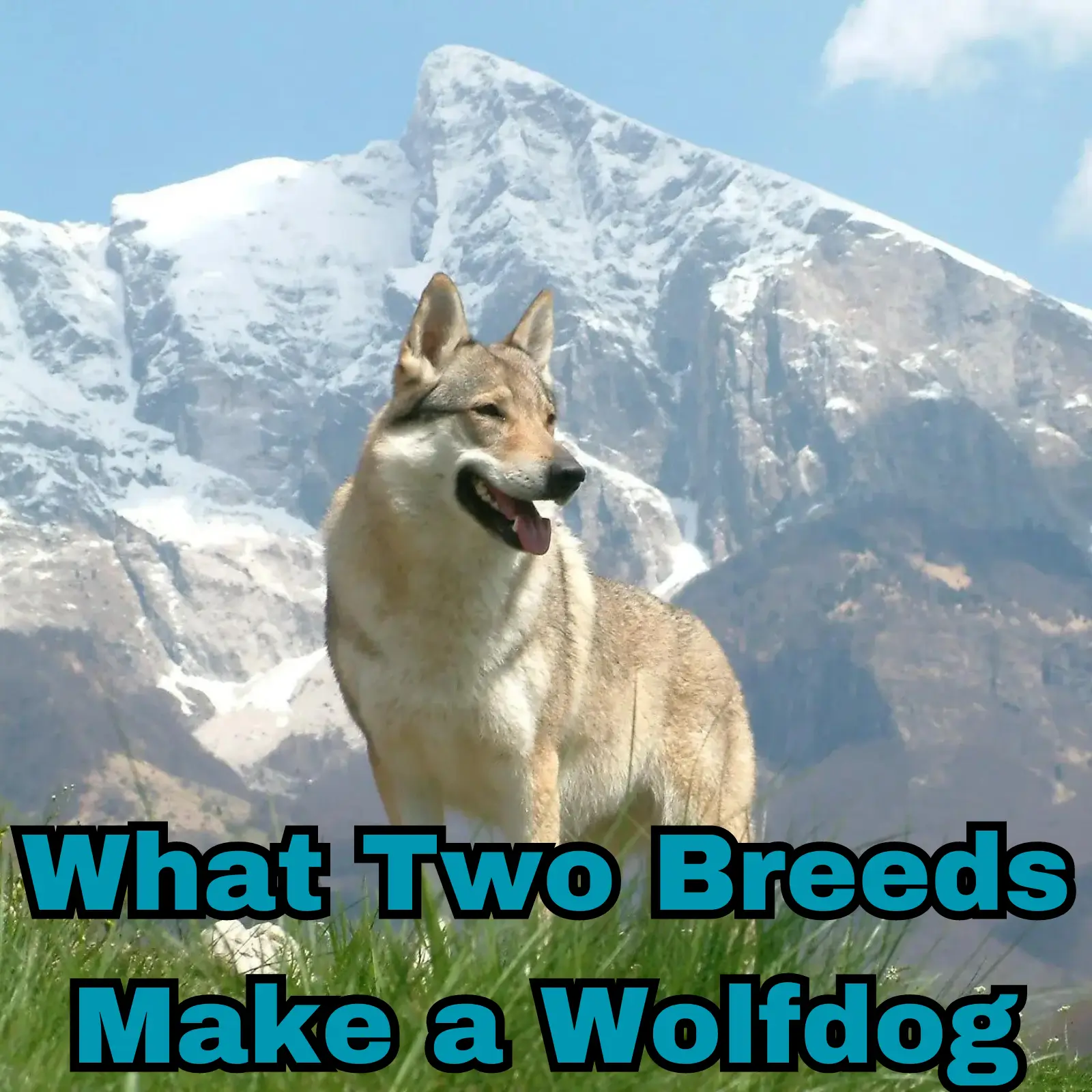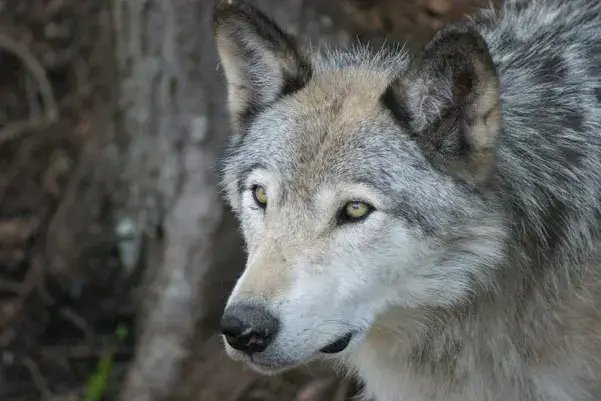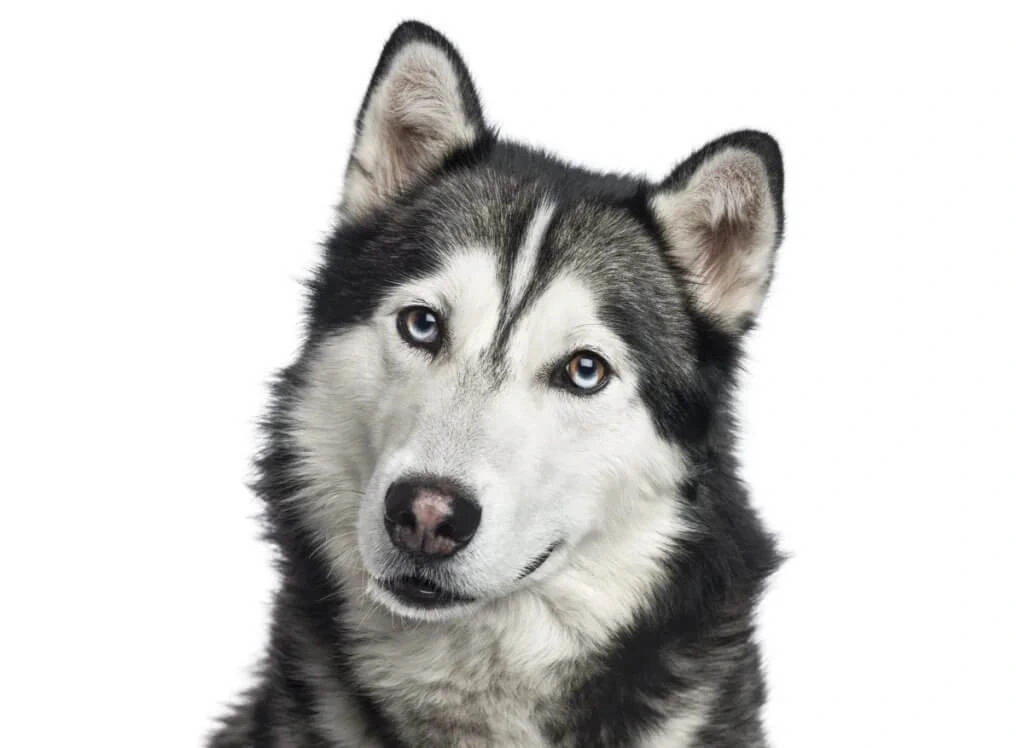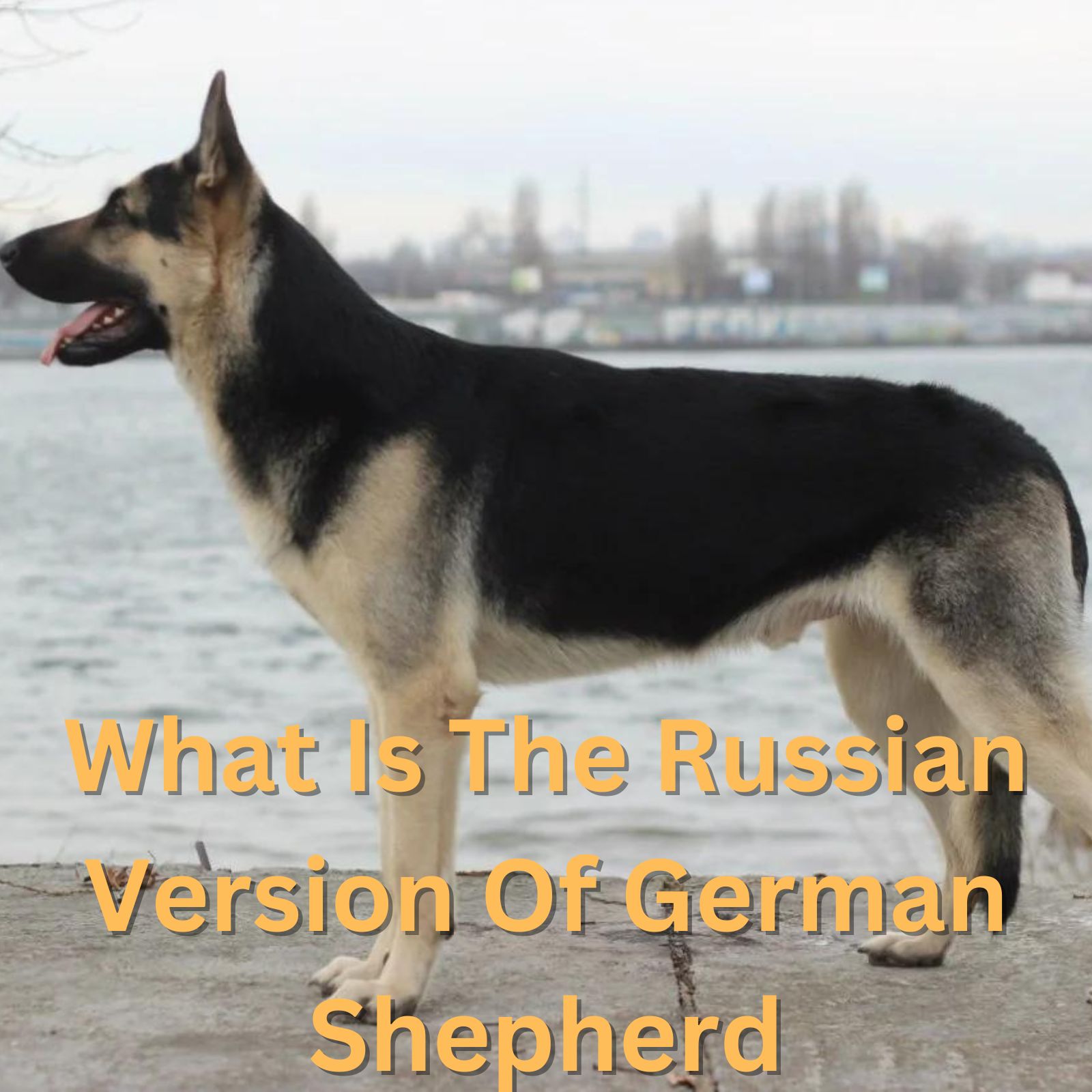
What Two Breeds Make a Wolfdog

What Two Breeds Make a Wolfdog
Introduction
It’s not uncommon for people to ask about wolfdogs where I live. Most people would ask: what two breeds make a Wolfdog? But they don’t really go more in depth. And while many different combinations are possible, the details can become complicated quick.
That is because “wolfdogs” are neither wolves nor dogs really, they are Hybrids and that makes this even more interesting than just another type of breed after all pretty much everyone agrees that wolves and dogs are different.
The Difference Between Wolves and Dogs
Wolves and dogs are both members of the Canidae family and share a common ancestor. However, over thousands of years of domestication, dogs have diverged significantly from wolves. While they may share some similarities in appearance and behaviour, there are many differences between them.
One of the most noticeable differences between wolves and dogs is their physical appearance. Wolves tend to have a leaner and more muscular build compared to most dog breeds. They have a larger head, longer legs, and a bushy tail. Dogs, on the other hand, come in a wide variety of shapes, sizes, and coat types, depending on the breed. They have been selectively bred for specific traits, resulting in a vast array of physical characteristics.
In terms of how they behave, wolves and dogs also have many differences. Wolves are highly social animals that live in packs and have a complex social structure. They rely on cooperation and teamwork for hunting and survival. Dogs, on the other hand, have been domesticated for thousands of years and have adapted to living within the safety of human civilization. They have developed a strong bond with humans and are generally trainable and extremely tolerant.
Another significant difference between wolves and dogs is their communication. Wolves have a wide range of vocalizations, including howls, growls, and rarely barks, which they use to communicate with other pack members over long distances. Dogs, on the other hand, have been bred to bark much more frequently to communicate with humans.
Genetically, wolves and dogs also differ. Wolves have 39 pairs of chromosomes, while dogs have 38 pairs. This slight difference in chromosome number is due to the domestication process and the selective breeding that has occurred over thousands of years.
The History of Wolfdogs

Wolf
The history of Wolfdogs, also known as Wolf hybrids, is a captivating journey that spans centuries and showcases the complex relationship between humans and wolves. These unique canines are the result of intentional breeding between domestic dogs and wolves, resulting in a hybrid that possesses traits from both species. The origins of Wolfdogs can be traced back to ancient times when humans first began to form a bond with wolves.
The history of Wolfdogs, also known as Wolf hybrids, is a captivating journey that spans centuries and showcases the complex relationship between humans and wolves. These unique canines are the result of intentional breeding between domestic dogs and wolves, resulting in a hybrid that possesses traits from both species. The origins of Wolfdogs can be traced back to ancient times when humans first began to form a bond with wolves.
The domestication of wolves is believed to have occurred around 15,000 years ago, as humans transitioned from a nomadic lifestyle to settled agricultural communities. Wolves were initially attracted to human settlements due to the availability of food scraps, and over time, a mutual understanding and cooperation developed between the two species. Humans recognized the benefits of having wolves as companions and protectors, while wolves gained access to a stable food source.
As humans began to selectively breed wolves for specific traits, such as hunting or guarding, the first steps towards creating Wolfdogs were taken. These early attempts at hybridization were likely driven by practical purposes, as the combination of wolf strength and dog obedience proved advantageous in various tasks. However, the breeding of Wolfdogs was not a widespread practice at this time.
Modern Wolfdog
It was not until the 18th and 19th centuries that intentional breeding between wolves and dogs gained popularity, particularly among European nobility and royalty. The desire to own exotic and unique pets led to the intentional pairing of wolves with various dog breeds. These early Wolfdogs were primarily bred for their striking appearance, with little consideration given to their behaviour or suitability as pets.
In the 20th century, interest in Wolfdogs grew beyond their aesthetic appeal. People began to appreciate their intelligence, loyalty, and unique characteristics. However, breeding Wolfdogs remained a controversial practice due to concerns about their behaviour and potential danger to humans. Many countries implemented strict regulations and restrictions on owning Wolfdogs, while others outright banned their ownership.
Despite the challenges, dedicated Wolfdog enthusiasts continued to breed and work with these animals, focusing on responsible breeding practices and socialization. Today, Wolfdogs are recognized as a distinct breed in some countries, with specific breed standards and organizations dedicated to their preservation and welfare.
Wolfdogs possess a mix of wolf and dog behaviours, often displaying high intelligence, independence, and a strong prey drive. They require experienced owners who can provide them with proper training, socialization, and a suitable environment. While Wolfdogs can make loyal and fascinating companions, it is crucial to remember that they are not suitable for everyone and require a deep understanding of their needs and behaviours.
The history of Wolfdogs is a testament to the enduring fascination humans have with these magnificent creatures. As we continue to learn more about their genetics, behaviour, and care, we can ensure the well-being of these remarkable animals while appreciating their connection to their wild ancestors.
Wait, what are Hybrids

Siberian Husky
Hybrids or crossbreeds, are the result of breeding between two different species or subspecies of animals. These animals are unique and different from either species, they have traits and characteristics from both their parents. Hybrids can occur in the wild but they are more commonly produced by humans breeding different species together for many different reasons.
One of the most common hybrids is the mule, which is a cross between a male donkey and a female horse. Mules are known for their strength, endurance, and surefootedness, making them valuable working animals. However, they are usually infertile due to the difference in the number of chromosomes between horses and donkeys.
This leads us to the problem of fertility, most hybrids can’t reproduce and must be constantly breed from the parent species, this is probably because of the difference between chromosomes. In the case of mules for example, donkeys have 62 chromosomes while horses have 64.
Another notable hybrid is the liger, a cross between a male lion and a female tiger. Ligers are the largest known cats and possess traits from both parent species. They have the strength and social behaviour of lions, combined with the agility and swimming ability of tigers. Due to the genetic differences between lions and tigers, ligers are also infertile.
In the case of liger, we also see another example of a cool trait of hybrids. While most common hybrids suffer from poor fitness it’s not always the case and actually in some exceptional cases hybrid vigour makes these animals stronger and bigger than both of their parents, this is also called Heterosis
Some hybrids may suffer from genetic abnormalities or have difficulty adapting to their environments. Additionally, hybridization can sometimes lead to the displacement or extinction of purebred species.
Are Wolfdogs Legal
The legality of owning a wolfdog, also known as a wolf hybrid, varies depending on the jurisdiction. In some places, owning a wolfdog is legal without any restrictions, while in others, there may be specific regulations or outright bans on owning them. It is important to research and understand the laws and regulations regarding wolfdogs in your specific area before considering owning one. Additionally, it is crucial to consider the unique needs and challenges associated with owning a wolfdog, as they require specialized care and handling due to their wild ancestry.
Conclusion
In conclusion, while the answer can be as simple as any dog mating with any wolf makes a wolfdog, the reality is that wolfdogs like any hybrid are a fascinating example of many biological wonders of the natural world.
And while wolfdogs may be slightly healthier, look cool and many other positive things, the reality is that these animals are not dogs, and as such they will require a special kind of person to take care of them, so almost no one should have one of these animals just like we don’t expect people to have lions at their homes!
Related
References
You may also like

What Country Has The Most Homeless Dogs

Why Do Dogs Let Cats Bully Them

What Is The Russian Version Of German Shepherd
Archives
- January 2026
- December 2025
- November 2025
- October 2025
- September 2025
- August 2025
- October 2023
- September 2023
- August 2023
- July 2023
- June 2023
- May 2023
- April 2023
- March 2023
- February 2023
- January 2023
- December 2022
- November 2022
- October 2022
- September 2022
- August 2022
- June 2022
- May 2022
- April 2022
- March 2022
- January 2022
- December 2021
- November 2021
- October 2021
- August 2021
- November 2020
- July 2020
- May 2020
- April 2020
- March 2020
- August 2018
- July 2018
- June 2018
- April 2018
- March 2018
Categories
- Aftercare Procedures
- Age Groups
- AI/ML
- Alternative Medicine
- Animal Health
- Animal Husbandry
- Animals
- Anti-Aging
- Architectural Design
- Art And Technology
- Auditory Science
- Augmented Reality
- Automation
- Babies
- Baby
- Beauty & Skincare
- Biohacking
- Biomechanics
- Book Reviews
- Breastfeeding
- Budgeting
- Budgeting Strategies
- Business
- Cardiovascular Health
- Career Advice
- Career Development
- Career Growth
- Cats
- Chess
- Chronobeauty
- Circular Economy
- Civic Technology
- Cleaning Tips
- Cloud Computing
- Cognitive Health
- Cognitive Performance
- Cognitive Science
- Community
- Community Building
- Community Engagement
- Community Living
- Computer Vision
- Consumer Guides
- Consumer Trends
- Container Gardening
- Content Analysis
- Content Non-Technical
- Content Strategy
- Cosmetic Chemistry
- Cultural Events
- Cycling
- Data Analysis
- Data Engineering
- Data Science
- Database
- Design Psychology
- Design Trends
- Developer Productivity
- Diet
- Diet
- Digital Identity
- Digital Media
- Digital Wellbeing
- DIY
- DIY Projects
- Dogs
- Engineering Culture
- Entertainment News
- Environmental Impact
- Environmental Science
- Equity Compensation
- Ethical AI
- Exercise
- Exercise Science
- Exercise Technique
- Exotic Pets
- Fall Gardening
- Family
- Family Health
- Family Life
- Fashion Business
- Fashion Industry
- Fashion News
- Fashion Tech
- Financial Analysis
- Financial Optimization
- Financial Planning
- Flooring Maintenance
- Food
- Food Psychology
- Food Safety
- Food Tech
- Functional Fitness
- Functional Training
- Future Of Work
- Garden Care
- Garden Maintenance
- Gardening Tips
- Geospatial Data
- Gig Economy
- Greece
- Greek
- Greek Food
- Green Technology
- Gymnastics
- Hardware Engineering
- Health
- Health And Wellness
- Health Informatics
- Health Science
- Health Tech
- Healthcare Management
- Healthy Eating
- Healthy Recipes
- Holistic Health
- Holistic Wellness
- Home & Living
- Home Decor
- Home Financing
- Home Health
- Home Improvement
- Home Maintenance
- Home Organization
- Home Styling
- Horticulture
- Household Chemistry
- Identity Management
- Industrial Design
- Industry Analysis
- Infant Nutrition
- Infrastructure Management
- Ingredient Deep Dive
- Integrative Health
- Integrative Medicine
- Interior Design
- Internet of Things
- Internet of Things (IoT)
- Invalid Request
- Investment Strategies
- Investment Strategy
- IoT
- Kids
- Leadership Development
- Learning Strategies
- Lifestyle
- Lifestyle Brands
- Lifestyle News
- Lifestyle Optimization
- Literary Criticism
- Literature
- Logistics Management
- Material Science
- Materials Science
- Meal Planning
- Media Analysis
- Meditation
- Mental Health
- Mental Performance
- Mental Wellness
- Miami
- Miami Food
- Mind And Body
- Minimalism
- Mobile Development
- Neuroscience
- No Applicable Categories
- Nutrition
- Nutrition News
- Open Source
- Operating Systems
- Operational Resilience
- Opinion
- Organization Tips
- Outdoor Living
- Over 40
- Over 50
- Over 60
- Parenting
- Parenting
- Parenting Strategies
- Performance
- Performance Optimization
- Personal Development
- Personal Finance
- Personal Growth
- Personal Productivity
- Pet Care
- Pet Safety
- Philosophy
- Politics
- Productivity
- Productivity Engineering
- Protein
- Psychology
- Psychology of Space
- Reading Culture
- Real Estate Investment
- Recipes
- Regulatory Compliance
- Remote Work
- Renovation Planning
- Resource Management
- Respiratory Health
- Responsible Pet Ownership
- Retail Strategy
- Robotics
- Science
- Seafood
- Seasonal Gardening
- Security
- Sedentary Health
- Self-Care
- Skincare Science
- Skincare Trends
- Sleep
- Sleep Health
- Smoothies
- Social Impact
- Soft Skills
- Soil Health
- Spatial Computing
- Spatial Design
- Stress Management
- Supplements
- Sustainability
- Sustainability Science
- Sustainable Engineering
- Sustainable Fashion
- Systems Engineering
- Tax Optimization
- Tax Strategy
- Tech Investment
- Travel
- Travel News
- Travel Safety
- Travel Tips
- Trend Analysis
- Uncategorized
- Urban Gardening
- Urban Planning
- User Experience
- Veggie
- Vietnam
- Virtual Events
- Volunteering
- Wealth Management
- Wearable Technology
- Wellness
- Wellness Technology
- Winter Gardening
- Work-Life Balance
- Workplace Culture
- World
- Writing
- Writing Skills
- Year In Review
- Yoga News
- Zero Waste

Leave a Reply